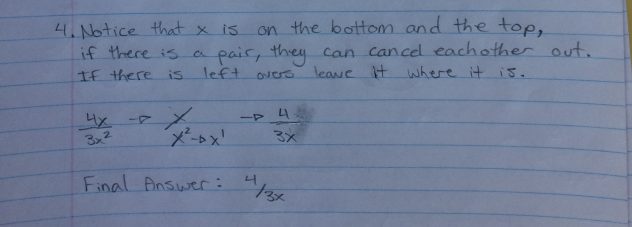 During the Unit of Rational Expressions I have learned a few things like multiplying and dividing rational expressions. Compared to adding and subtracting these expressions it is a tad bit easier. I have learned to Just Do IT!
During the Unit of Rational Expressions I have learned a few things like multiplying and dividing rational expressions. Compared to adding and subtracting these expressions it is a tad bit easier. I have learned to Just Do IT!
Steps When Multiplying Rational Expressions
- Simplify: Can do so by factoring to see if anything from the numerator and the denominator will cancel out.
- Multiply across: Just Do It!
- Simplify: By taking out a common factor if possible
- Variables: You can simplify variables too! If there is a
on the denominator and a single x in the numerator we know that at least one pair can cancel out. The leftover variable will be left on the same side that it is on.
- State any Non Permissible values
Example 1:
Step 1: Simplify: Get the simplest form of each fraction by taking out a common factor.
In this case it is two
could be a different number for the two fractions, it’s not always the same.
You can also simplify the the variables
Step 2: Multiply across (Just Do It!)
Step 3: Simplify by taking out common factors if possible
Step 4: Variables
Step 5: State any Non Permissible Values
This is how you would multiply rational expressions
How to Divide Rational Expressions
Steps When Dividing Rational Expressions
Dividing rational expressions is very similar to that of multiplying. There is just one extra step. It is to reciprocate the fraction that is to right after the divide sign.
- Simplify: Can do so by factoring
- Reciprocate
- Cancel any pair terms
- Multiply across: Just Do It!
- Simplify: By taking out a common factor if possible
- Variables: You can simplify variables too! If there is a
on the denominator and a single x in the numerator we know that at least one pair can cancel out. The left over variable will be left on the same side that it is on.
- State any Non Permissible values
Example 2:
Step 1: Simplify (factor)
Step 2: Reciprocate (this gets rid of the dividing sign and makes it a multiplying sign)
Step 3: Cancel out any pair terms
Step 4: Multiply Across (Just Do It!)
State the Non Permissible Values
FINAL ANSWER:
This is how you would divide rational expressions.









